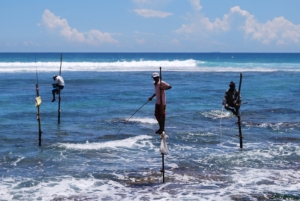Sustainable Fishing in Sri Lanka
 Fishing is a vital industry in Sri Lanka, both for its population’s livelihoods and its food source. However, issues surrounding economic and environmental crises have placed urgent demands on the sector to modernize.
Fishing is a vital industry in Sri Lanka, both for its population’s livelihoods and its food source. However, issues surrounding economic and environmental crises have placed urgent demands on the sector to modernize.
The sight of traditional stilt fishing in Sri Lanka is eye-catching and unique. Fishers sit delicately poised atop wooden beams high above the Indian Ocean. Patience, balance and finesse are required for fishers to successfully pluck their catch from the waters beneath. The tradition originated from the post-World War II food shortages, but healthier food supplies mean it is now mostly performative. For this island nation of 22 million, fishing is woven into the fabric of its national identity.
Fishing in Sri Lanka
Not only is fishing in Sri Lanka significant because of its contribution to the diet of Sri Lankans, with 50% of its animal protein intake coming from seafood, but it is also an important part of its economy. Fishing provides a lucrative export market, valued at over $290m in 2022. In total fishing supports the livelihoods of around 3.6 million Sri Lankans.
For many years, environmental factors have threatened the livelihoods of fishing communities. A combination of overfishing and ecosystem damage has caused a decline in fish stocks. Furthermore, climate change has meant that destructive extreme weather events are now happening with increased regularity in Sri Lanka. Evidence from 1974 to 2004 shows floods and droughts are occurring more frequently, and projections have warned that the severity and regularity of cyclones could increase.
These already vulnerable fishing villages have faced yet more strain in the previous few years. COVID-19 has dealt a heavy blow to the fishing industry. In 2020, fish harvests declined up to 20% and exports were down as much as 26%, according to the World Bank. This forced Sri Lanka to import $218 million of fish in 2020 just to satisfy national food demands. To make matters worse, a national crisis has followed the economic downturn of COVID-19.
Economic Crisis
A gradually deepening financial crisis, which COVID-19 had exacerbated, exploded in 2022. The result has been economic and political turmoil that has had dire humanitarian consequences. Deteriorating social conditions such as fuel, food and energy shortages and heightening inflation prompted mass anti-government protests in the spring of 2022.
All 26 cabinet members other than the President and Prime Minister resigned on April 3, 2022, and less than 10 days later, Sri Lanka defaulted on its $51 billion sovereign debt payments it owed to international creditors, The Guardian reports. Months of violent protests culminated on July 9, 2022, when protesters stormed President Rajapanka’s residence and set Prime Minister Wickremesinghe’s house ablaze. The President fled to the Maldives and resigned on July 13, 2022.
The stark reality of economic collapse in people’s lives is poverty. UNICEF estimated in June 2022 that 5,711,089 people were in need of humanitarian assistance in Sri Lanka. Figures from The World Bank show that between 2019 and 2022, poverty in Sri Lanka rose from 11.3% to 25%.
Sri Lankans are still struggling to access food. In September 2022, with food inflation at 94.9%, 30% of Sri Lankans faced acute food insecurity. Although beginning to ease, food inflation in April 2023 remained high at 30.6%. These numbers create more impetus to create efficient and sustainable fishing in Sri Lanka.
Growth Opportunities
In March 2023, the International Monetary Fund (IMF) approved a $3 billion loan to support Sri Lanka’s economic policies and reforms, targeted at the most vulnerable. This gives renewed hope for economic and social recovery.
Spoilage is an obstacle to greater revenues, especially with yellowfin tuna, one of Sri Lanka’s most popular and lucrative fish. Half of all yellowfin tuna caught is spoiled before it reaches the shore and many catches do not meet export standards, according to the World Bank. Modernizing fishing vessels to improve their refrigeration capacity and redesigning fishing routes to reduce the time boats spend at sea could both reduce instances of spoilage. This could increase revenues without the need to catch any more fish.
Making Changes
Ensuring fish stocks remain healthy is also key to achieving sustainable fishing in Sri Lanka. Protecting vulnerable species, like the yellowfin tuna, could require a commitment to conserving and even regenerating coastal ecosystems. Community involvement in assessing stock statuses to protect against overfishing could also hold significance. Achieving sustainable fishing in Sri Lanka can potentially provide an example of the kind of community-focused investment required to put the nation back on a path of stability and progress.
– Henry Jones
